Optimization and Sensitivity Analysis of Using Renewable Energy Resources for Yanbu City
Abstract
:1. Introduction
Literature Review
2. Materials and Methods
2.1. Site Suitability Analysis
2.1.1. Study Area
2.1.2. Criteria Selection and Weighting
- Climatic factors: Solar PV output (PVOUT), wind energy density, average temperature, and precipitation.
- Topographic factors: Aspect, elevation, and slope.
- Economic factors: Proximity to transmission lines and proximity to roads.
- Environmental factors: Proximity to protected areas.
2.1.3. Weighted Linear Combination (WLC)
2.2. Techno-Economic Analysis
2.2.1. Location and Load Profile
2.2.2. Solar and Temperature Resources
2.2.3. Wind Resources
2.2.4. System Design and Component Parameters
- WT (850 MW) system
- PV (850 MW) system
- WT (425 MW)–PV (425 MW) system
- WT (212.5 MW)–PV (637.5 MW) system
- WT (637.5 MW)–PV (212.5 MW) system
- WT (600 MW)–BS (250 MW) system
- PV (600 MW)–BS (250 MW) system
- WT (300 MW)–PV (300 MW)–BS (250 MW) system
- WT (150 MW)–PV (450 MW)–BS (250 MW) system
- WT (450 MW), PV (150 MW)–BS (250 MW) system
2.2.5. Mathematical Modeling for Wind Turbine Module
2.2.6. Sensitivity Factors
2.2.7. Job Creation
3. Results and Discussion
- Data Availability: The accuracy of the simulation results heavily depends on the availability and quality of the input data, such as weather patterns, load demand, and economic parameters. Any discrepancies or gaps in data could affect the reliability of the outcomes.
- Technological Assumptions: This study assumes current technological capabilities and costs for renewable energy systems. Future advancements or changes in technology and cost could alter the findings.
- Geographic Specificity: The results are specific to Yanbu city and may not be directly applicable to other regions with different climatic, topographical, or infrastructural conditions.
- Economic Factors: Fluctuations in economic variables such as inflation rates, discount rates, and energy prices could impact the cost-effectiveness and feasibility of the proposed systems.
- Environmental and Social Impact Assessments: While the study estimates job creation, it does not comprehensively address other social impacts, such as community acceptance or potential disruptions during the installation phase. Environmental impacts beyond CO2 emissions are also not fully explored.
- Sensitivity Analysis Scope: Although a sensitivity analysis was performed, it may not cover all possible variations in key parameters, potentially overlooking some extreme scenarios or unexpected changes.
- Policy and Regulatory Framework: The study does not account for potential changes in policies or regulations that could influence the deployment and operation of renewable energy systems.
4. Conclusions
- Ten grid-connected hybrid system designs combining solar PV, wind turbines, and battery storage were simulated and optimized using the HOMER Grid software.
- Techno-economic evaluation showed that a PV-only system with an 850 MW capacity achieved the lowest NPC of USD 201 million and LCOE of 0.0344 USD/kWh, making it the most cost-effective solution. Despite the fact that solar PV systems offer economic advantages and efficient energy production, their spatial requirements are a significant consideration. PV installations demand considerable land area, which can be a limitation in regions with competing land use pressures such as agriculture, urban development, or conservation. Nevertheless, the advantages of PV systems often outweigh this concern. In Saudi Arabia, the availability of vast free land mitigates concerns about the spatial footprint of solar PV systems. The country’s extensive arid and semi-arid landscapes provide ample space for the deployment of large-scale solar farms. However, the benefits that solar PV offers in terms of energy generation and cost-effectiveness outweigh this consideration.
- A hybrid WT–PV configuration of 212.5 MW WT and 637.5 MW PV was also proposed to support local manufacturing objectives.
- Sensitivity analysis demonstrated the robustness of the results under variations in key parameters like solar irradiation, wind speed, temperature, and load demand.
- All proposed systems provided over a 91% renewable energy contribution to meet Yanbu city’s load while reducing CO2 emissions by 53% compared to grid supply only.
- Up to 1152 jobs were estimated to be created through the development of renewable energy projects in Yanbu city.
- Integrate large-scale energy storage solutions to further enhance grid flexibility and accommodate higher renewable energy penetration levels.
- Perform time series simulations considering intra-hour solar–wind complementarity patterns to optimize hybrid system component sizing.
- Develop regional renewable energy master plans integrating the multiple nearby suitable sites identified through this study.
- Conduct further techno-economic analyses incorporating demand response strategies and evolving power market conditions.
- Incorporate Dynamic Modeling: Future research could benefit from dynamic modeling that accounts for real-time changes in environmental and economic conditions to provide more robust and adaptable solutions.
- Expand Geographical Scope: Similar studies should be conducted in various regions with different climatic and topographical features to generalize the findings and enhance their applicability.
- Advanced Data Analytics: Advanced data analytics and machine learning techniques can be utilized to improve the accuracy and predictive capabilities of the models used in techno-economic assessments.
- Policy Analysis: A thorough analysis of potential policy changes and their impacts on the feasibility and sustainability of renewable energy systems should be performed.
- Broader Social Impact Assessment: The assessment of social impacts can be expanded to include community acceptance, potential displacement, and other socio-economic factors that may influence the deployment of renewable energy projects.
- Waste Management Strategy for PV Systems: The long-term sustainability of PV systems extends beyond their operational efficiency to include the management of waste generated at the end of their life cycle. Establishing a comprehensive waste management strategy for the disposal and recycling of PV panels is essential, particularly given their lifespan of 25 to 30 years. In Yanbu city, integrating circular economy principles can facilitate responsible disposal and recycling, involving collaboration with manufacturers and recycling facilities to ensure that materials are reclaimed and reused.
Author Contributions
Funding
Institutional Review Board Statement
Informed Consent Statement
Data Availability Statement
Acknowledgments
Conflicts of Interest
References
- Ministry of Energy Gate Saudi Ministry of Energy. Renewable Energy. Available online: https://www.moenergy.gov.sa/ar/OurPrograms/RenewableEnergy/Pages/default.aspx (accessed on 29 June 2024).
- Imam, A.A.; Al-Turki, Y.A.; Sreerama Kumar, R. Techno-Economic Feasibility Assessment of Grid-Connected PV Systems for Residential Buildings in Saudi Arabia-A Case Study. Sustainability 2020, 12, 262. [Google Scholar] [CrossRef]
- Alghamdi, O.A.; Alhussainy, A.A.; Alghamdi, S.; AboRas, K.M.; Rawa, M.; Abusorrah, A.M.; Alturki, Y.A. Optimal Techno-Economic-Environmental Study of Using Renewable Energy Resources for Yanbu City. Front. Energy Res. 2023, 10, 1115376. [Google Scholar] [CrossRef]
- Zidan, A.; Gabbar, H.A. A Zidan; Gabbar, H.A.Comparative analyses of scheduling scenarios to facilitate optimal operation of interconnected micro energy grids. In Proceedings of the 2017 IEEE International Conference on Smart Energy Grid Engineering (SEGE), Oshawa, ON, Canada, 14–17 August 2017; pp. 90–95. [Google Scholar] [CrossRef]
- Renewable energy project development office. Saudi Arabia National Renewable Energy Program. Available online: https://powersaudiarabia.com.sa/web/index.html (accessed on 17 November 2024).
- Piotr Bojek Iea. Available online: https://www.iea.org/energy-system/renewables/solar-pv#tracking (accessed on 17 November 2024).
- Piotr Bojek Iea. Available online: https://www.iea.org/energy-system/renewables/wind#tracking (accessed on 17 November 2024).
- Khan, M.J.; Yadav, A.K.; Chatterji, S.; Mathew, L. Techno Economic Analysis of PV-Wind-Grid Connected Systems for Power Generation in India. In Proceedings of the 2015 Annual IEEE India Conference (INDICON), New Delhi, India, 17–20 December 2015; IEEE: Piscataway, NJ, USA, 2015; pp. 1–5. [Google Scholar]
- Ritu, K.R.; Wadhwani, A.K.; Rajoria, A. Techno-Economic Comparison of On Grid and Off Grid Hybrid WT/Solar Photo Voltaic Connected Power Generating Unit Using HOMER. In Proceedings of the 2018 International Conference on Advanced Computation and Telecommunication (ICACAT), Bhopal, India, 28–29 December 2018; IEEE: Piscataway, NJ, USA, 2018; pp. 1–9. [Google Scholar]
- Oueslati, H.; Ben Mabrouk, S.; Ben Mabrouk, A.; La Cascia, D.; Zizzo, G.; Dusonchet, L.; Favuzza, S.; Massaro, F. Feasibility Analysis and Study of a Grid-Connected Hybrid Electric System: Application in the Building Sector. In Proceedings of the 2016 IEEE 16th International Conference on Environment and Electrical Engineering (EEEIC), Florence, Italy, 7–10 June 2016; IEEE: Piscataway, NJ, USA, 2016; pp. 1–6. [Google Scholar]
- Ahmed, P.; Rahman, M.F.; Mahmudul Haque, A.K.M.; Mohammed, M.K.A.; Ishraque Toki, G.F.; Ali, M.H.; Kuddus, A.; Rubel, M.H.K.; Hossain, M.K. Feasibility and Techno-Economic Evaluation of Hybrid Photovoltaic System: A Rural Healthcare Center in Bangladesh. Sustainability 2023, 15, 1362. [Google Scholar] [CrossRef]
- Nkambule, M.S.; Hasan, A.N.; Shongwe, T. Performance and Techno-Economic Analysis of Optimal Hybrid Renewable Energy Systems for the Mining Industry in South Africa. Sustainability 2023, 15, 16766. [Google Scholar] [CrossRef]
- Pavan Kumar, Y.V.; Bhimasingu, R. Renewable Energy Based Microgrid System Sizing and Energy Management for Green Buildings. J. Mod. Power Syst. Clean Energy 2015, 3, 1–13. [Google Scholar] [CrossRef]
- Nurunnabi, M.; Roy, N.K.; Hossain, E.; Pota, H.R. Size Optimization and Sensitivity Analysis of Hybrid Wind/PV Micro-Grids- A Case Study for Bangladesh. IEEE Access 2019, 7, 150120–150140. [Google Scholar] [CrossRef]
- Shezan, S.A.; Ishraque, M.F.; Muyeen, S.M.; Abu-Siada, A.; Saidur, R.; Ali, M.M.; Rashid, M.M. Selection of the Best Dispatch Strategy Considering Techno-Economic and System Stability Analysis with Optimal Sizing. Energy Strategy Rev. 2022, 43, 100923. [Google Scholar] [CrossRef]
- Nallolla, C.A.; Vijayapriya, P. Optimal Design of a Hybrid Off-Grid Renewable Energy System Using Techno-Economic and Sensitivity Analysis for a Rural Remote Location. Sustainability 2022, 14, 15393. [Google Scholar] [CrossRef]
- Aziz, A.S.; Tajuddin, M.F.N.; Zidane, T.E.K.; Su, C.L.; Mas’ud, A.A.; Alwazzan, M.J.; Alrubaie, A.J.K. Design and Optimization of a Grid-Connected Solar Energy System: Study in Iraq. Sustainability 2022, 14, 8121. [Google Scholar] [CrossRef]
- Saqr, A.M.; Nasr, M.; Fujii, M.; Yoshimura, C.; Ibrahim, M.G. Delineating Suitable Zones for Solar-Based Groundwater Exploitation Using Multi-Criteria Analysis: A Techno-Economic Assessment for Meeting Sustainable Development Goals (SDGs). Groundw. Sustain. Dev. 2024, 25, 101087. [Google Scholar] [CrossRef]
- Abd-Elmaboud, M.E.; Saqr, A.M.; El-Rawy, M.; Al-Arifi, N.; Ezzeldin, R. Evaluation of Groundwater Potential Using ANN-Based Mountain Gazelle Optimization: A Framework to Achieve SDGs in East El Oweinat, Egypt. J. Hydrol. Reg. Stud. 2024, 52, 101703. [Google Scholar] [CrossRef]
- Saqr, A.M.; Nasr, M.; Fujii, M.; Yoshimura, C.; Ibrahim, M.G. Monitoring of Agricultural Expansion Using Hybrid Classification Method in Southwestern Fringes of Wadi El-Natrun, Egypt: An Appraisal for Sustainable Development; Springer: Singapore, 2023; pp. 349–362. [Google Scholar]
- Saqr, A.M.; Nasr, M.; Fujii, M.; Yoshimura, C.; Ibrahim, M.G. Optimal Solution for Increasing Groundwater Pumping by Integrating MODFLOW-USG and Particle Swarm Optimization Algorithm: A Case Study of Wadi El-Natrun, Egypt; Springer: Singapore, 2023; pp. 59–73. [Google Scholar]
- Imam, A.A.; Abusorrah, A.M.; Marzband, M. Potential of Concentrated Solar Power in the Western Region of Saudi Arabia: A GIS-Based Land Suitability Analysis and Techno-Economic Feasibility Assessment. IEEE Access 2024, 12, 1570–1598. [Google Scholar] [CrossRef]
- Lu, Y.; Khan, Z.A.; Alvarez-Alvarado, M.S.; Zhang, Y.; Huang, Z.; Imran, M. A Critical Review of Sustainable Energy Policies for the Promotion of Renewable Energy Sources. Sustainability 2020, 12, 5078. [Google Scholar] [CrossRef]
- Imam, A.A.; Abusorrah, A.; Marzband, M. Potentials and Opportunities of Solar PV and Wind Energy Sources in Saudi Arabia: Land Suitability, Techno-Socio-Economic Feasibility, and Future Variability. Results Eng. 2024, 21, 101785. [Google Scholar] [CrossRef]
- Ministry of Energy Gate Saudi Ministry of Energy. Available online: https://www.moenergy.gov.sa/en/DigitalDocuments/OpenData/Pages/default.aspx (accessed on 29 June 2024).
- SEC Website Saudi Electricity Company. Available online: https://www.se.com.sa/en/Ourservices/ColumnC/Bills-and-Consumption/ConsumptionTariffs (accessed on 29 June 2024).
- Website Saudi General Authority of Statistics. Available online: https://www.stats.gov.sa/en/news/475 (accessed on 29 June 2024).
- Ram, M.; Aghahosseini, A.; Breyer, C. Job Creation during the Global Energy Transition towards 100% Renewable Power System by 2050. Technol Forecast. Soc Chang. 2020, 151, 119682. [Google Scholar] [CrossRef]

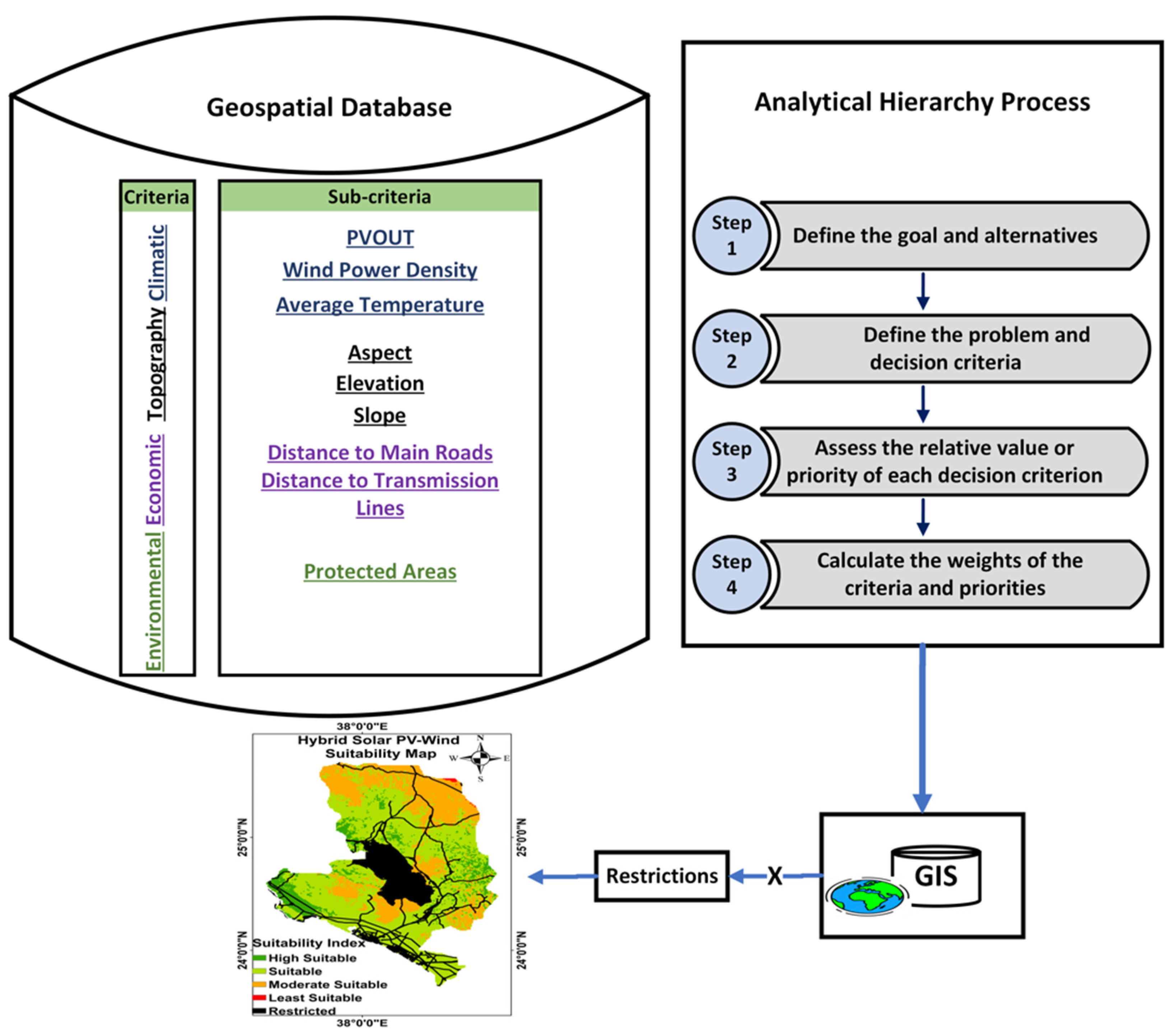
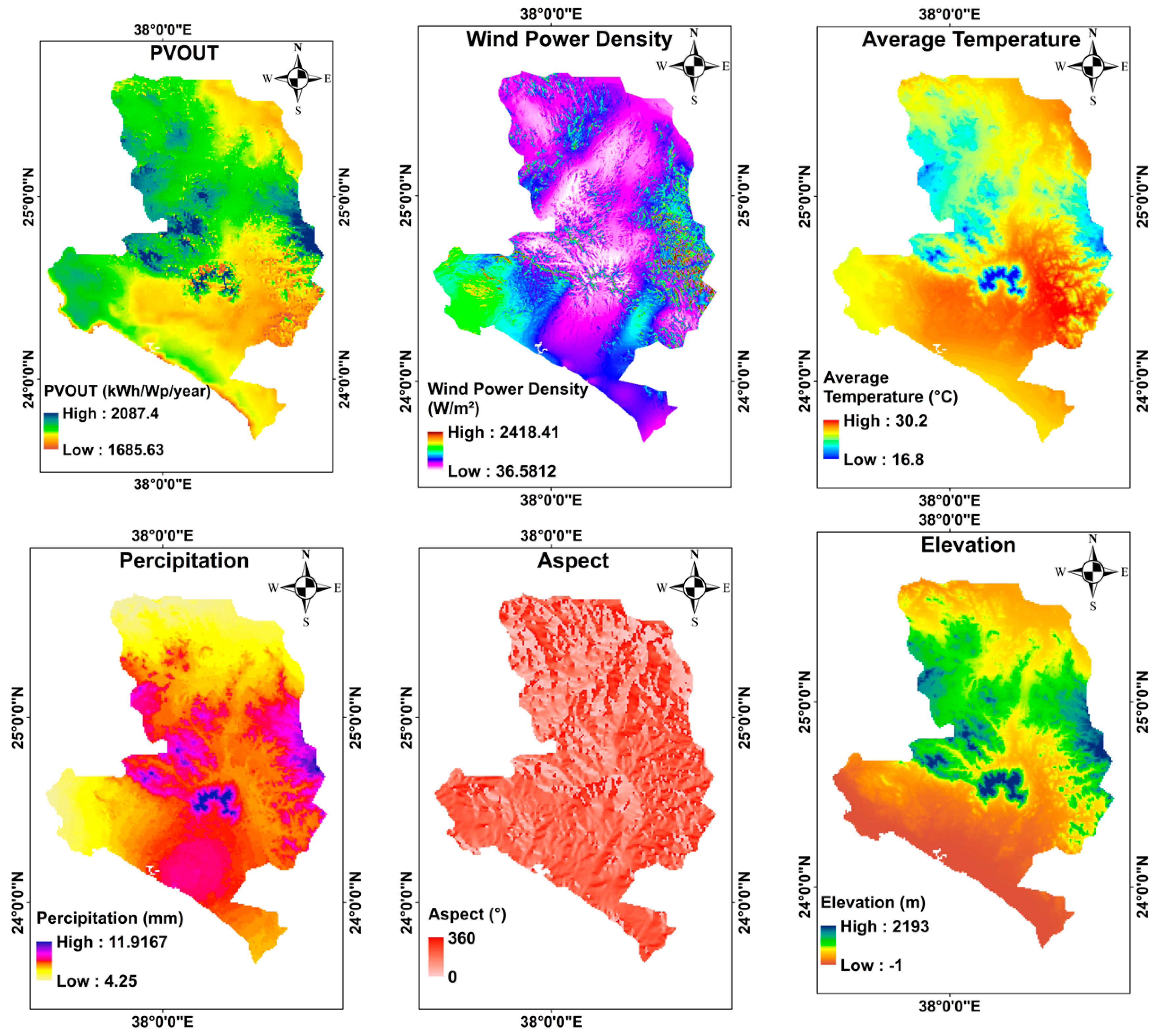
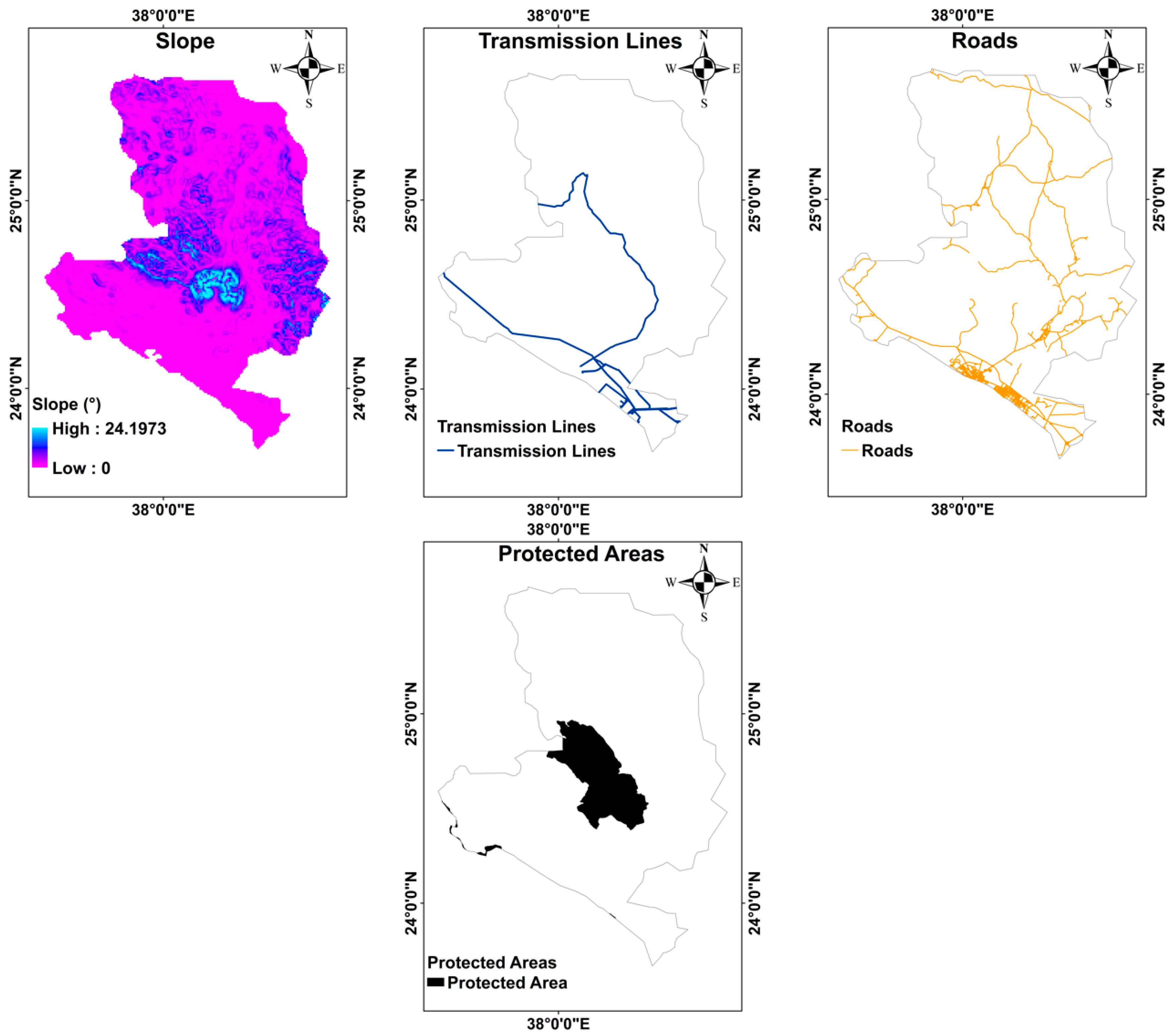
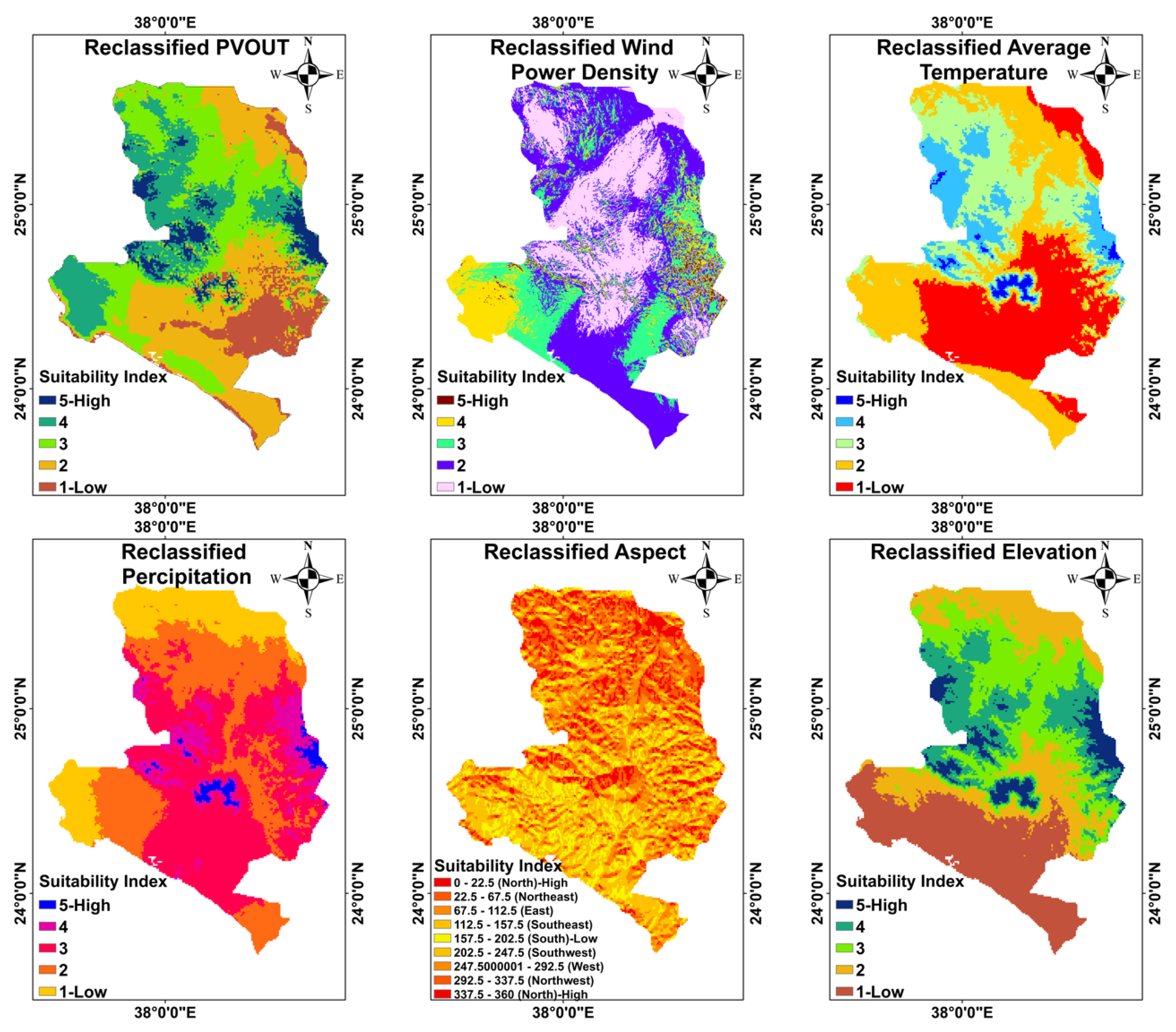
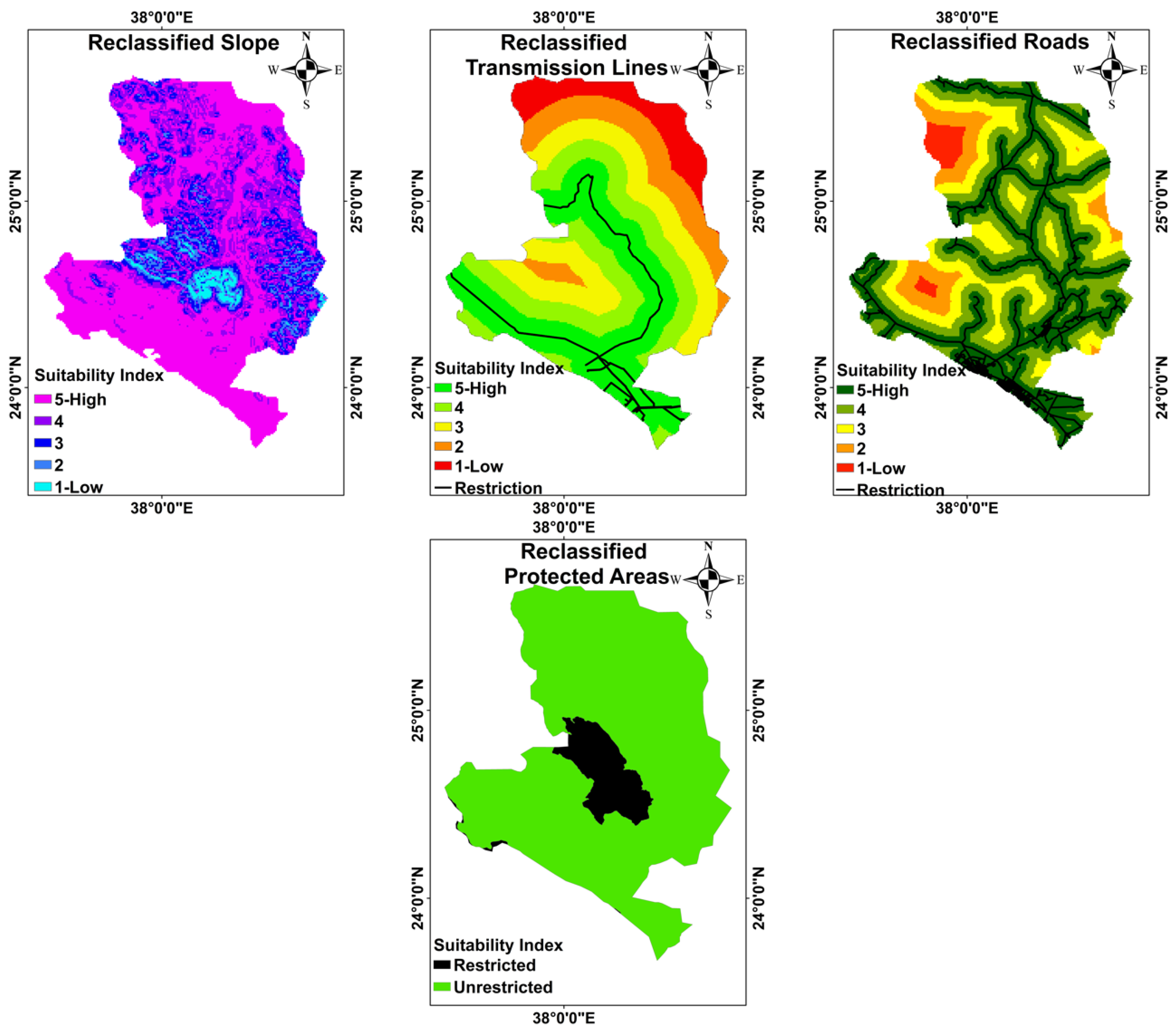

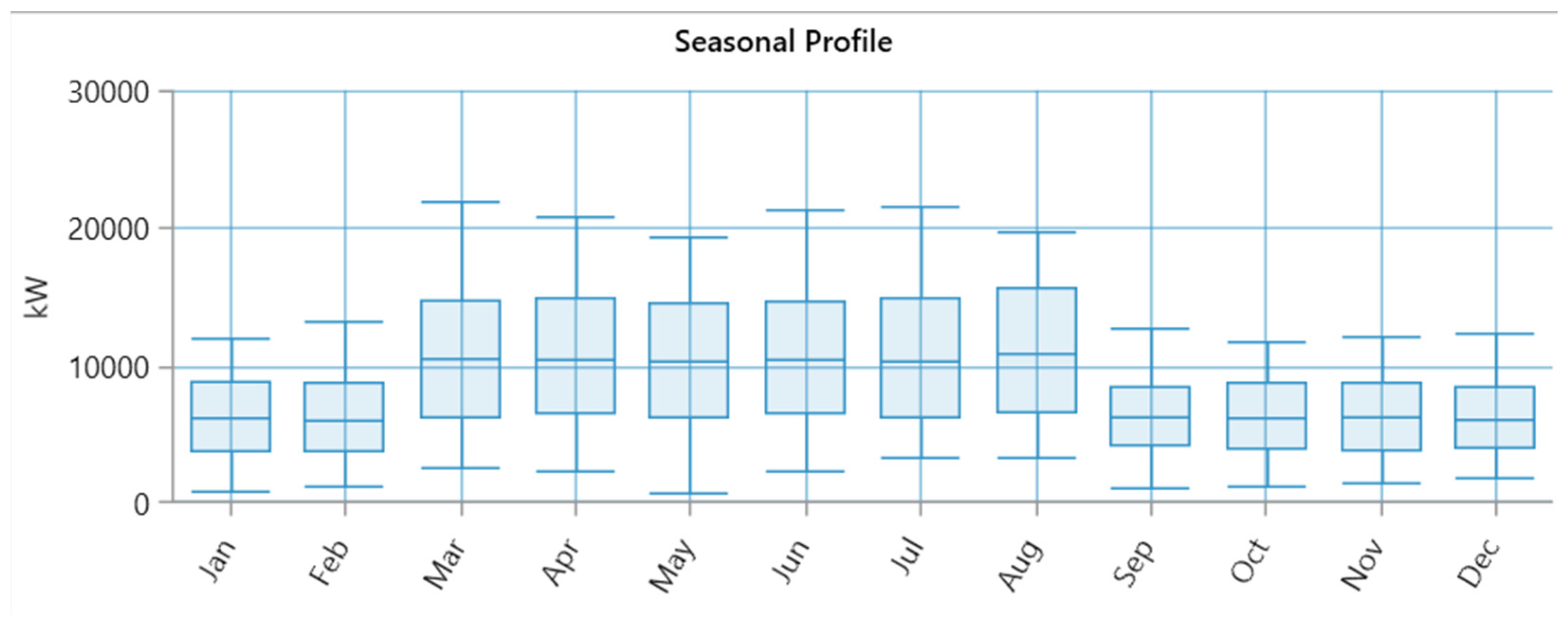
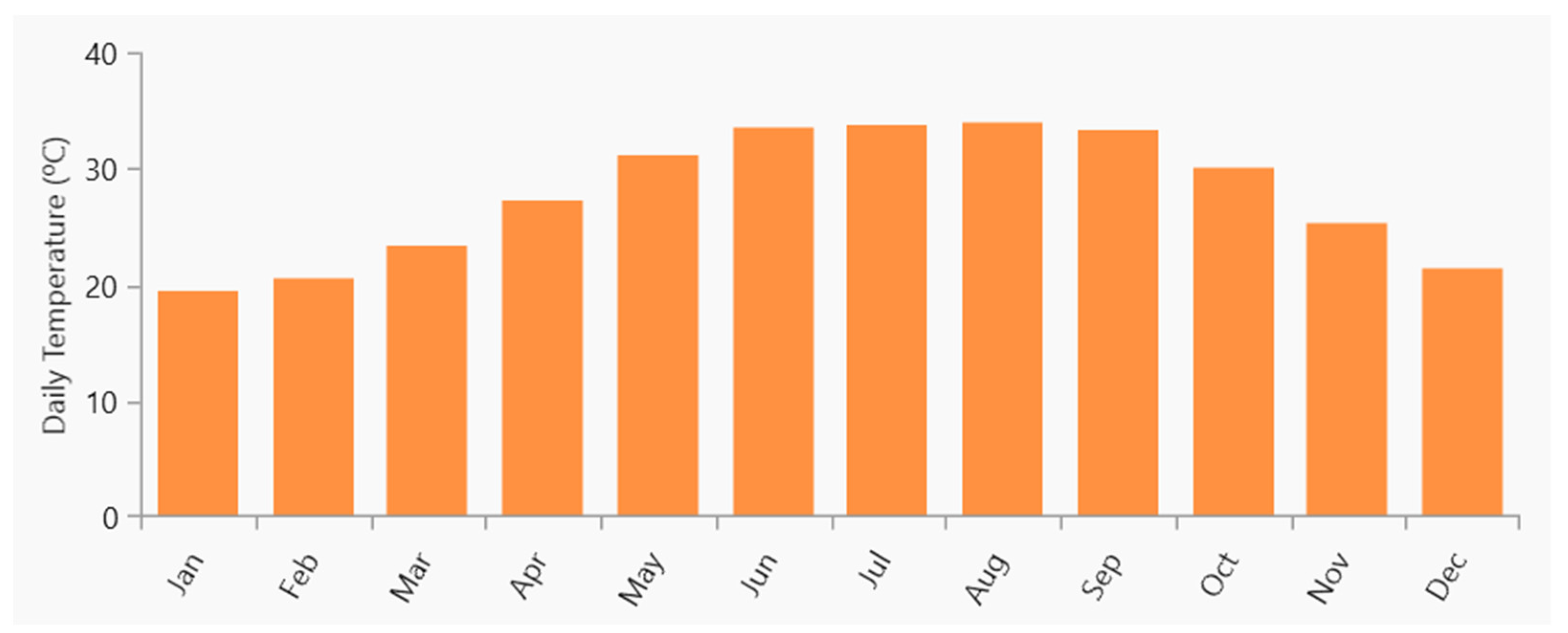
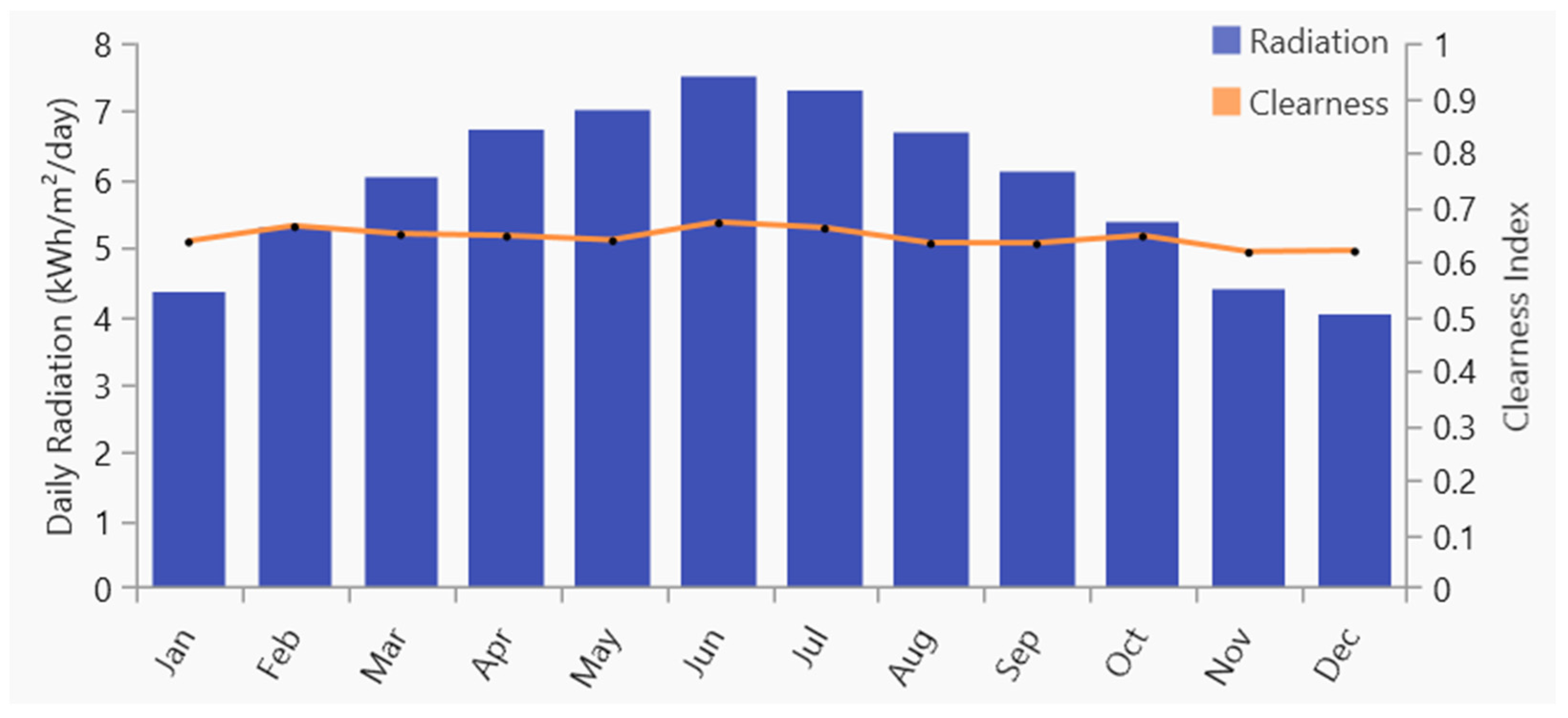





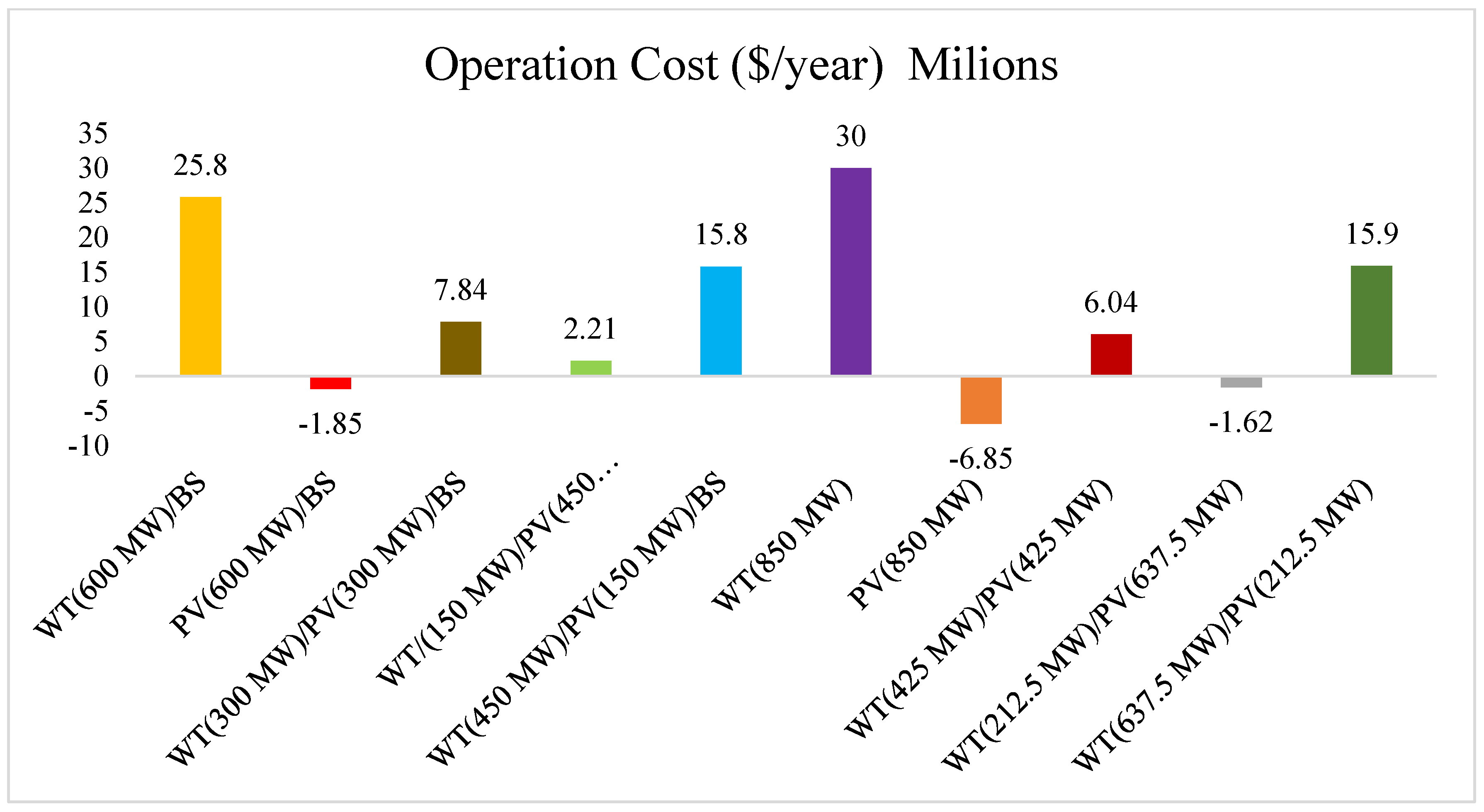
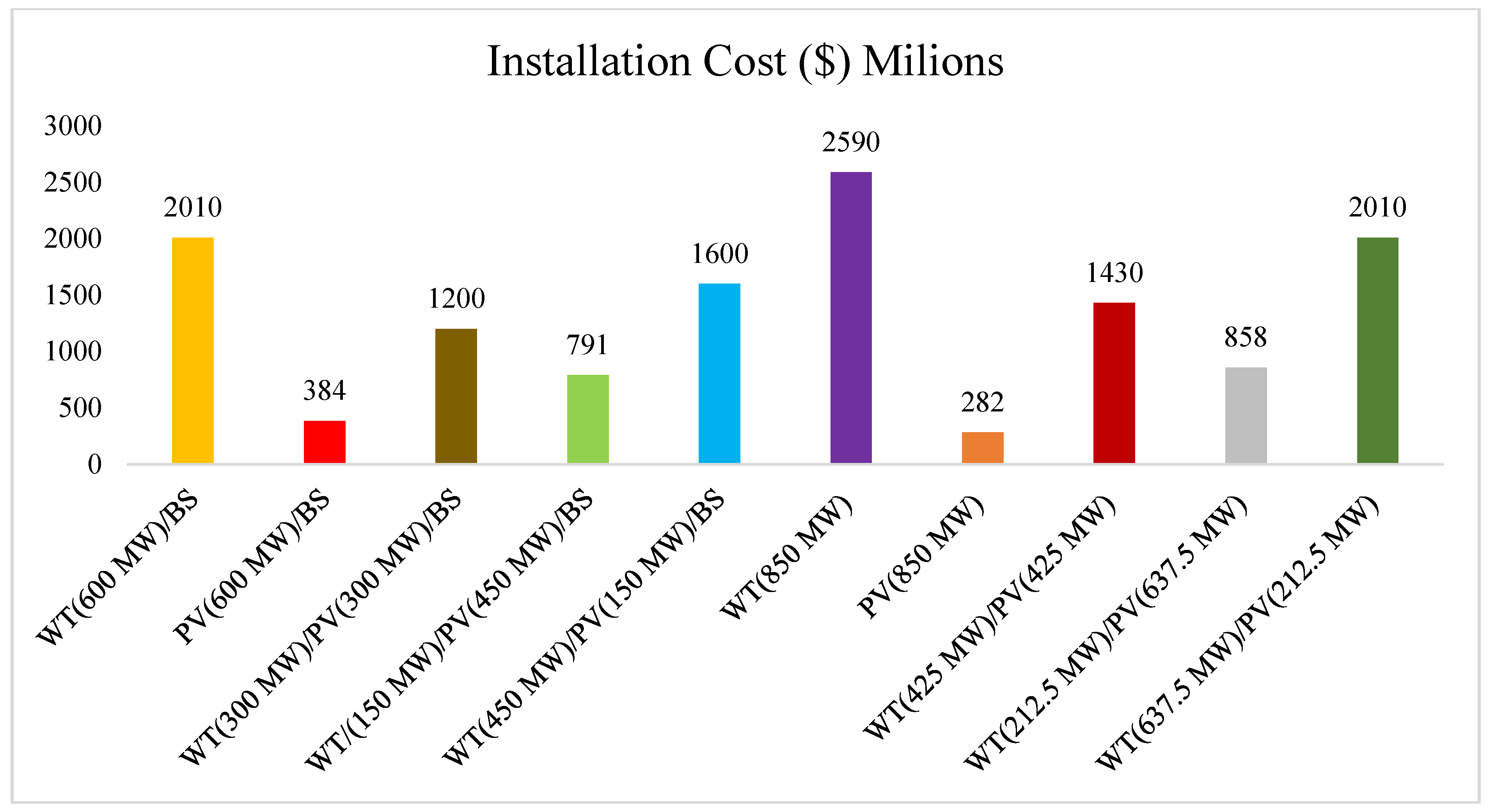





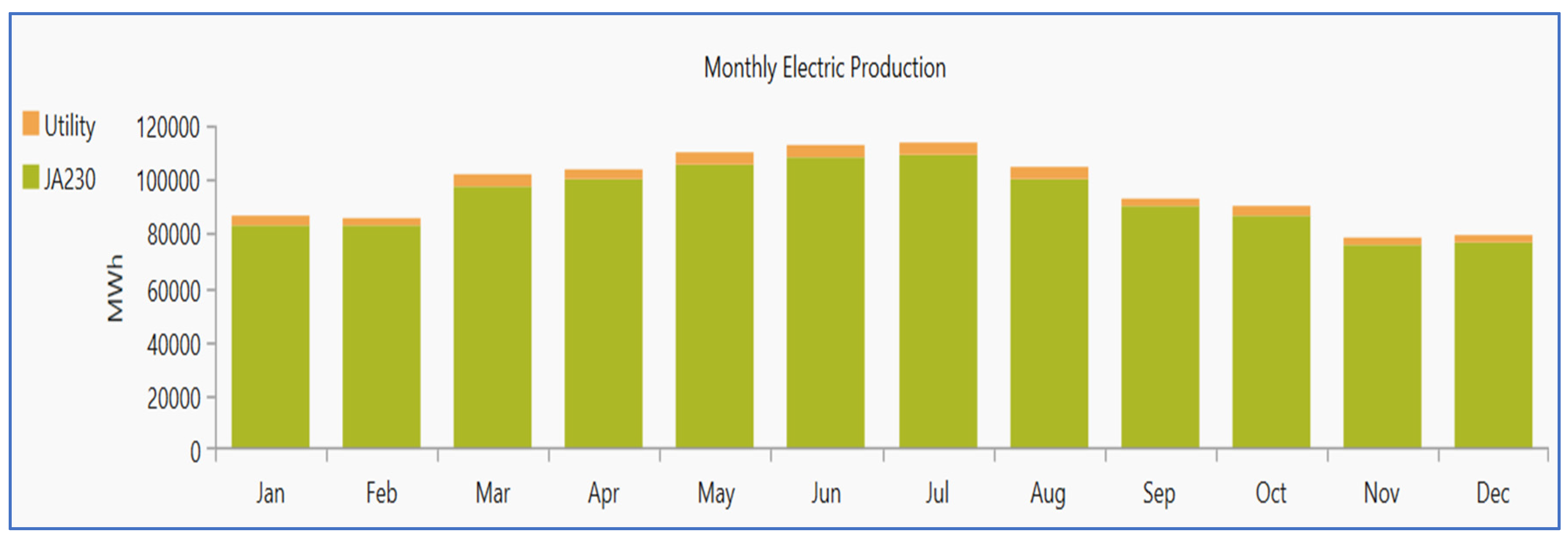
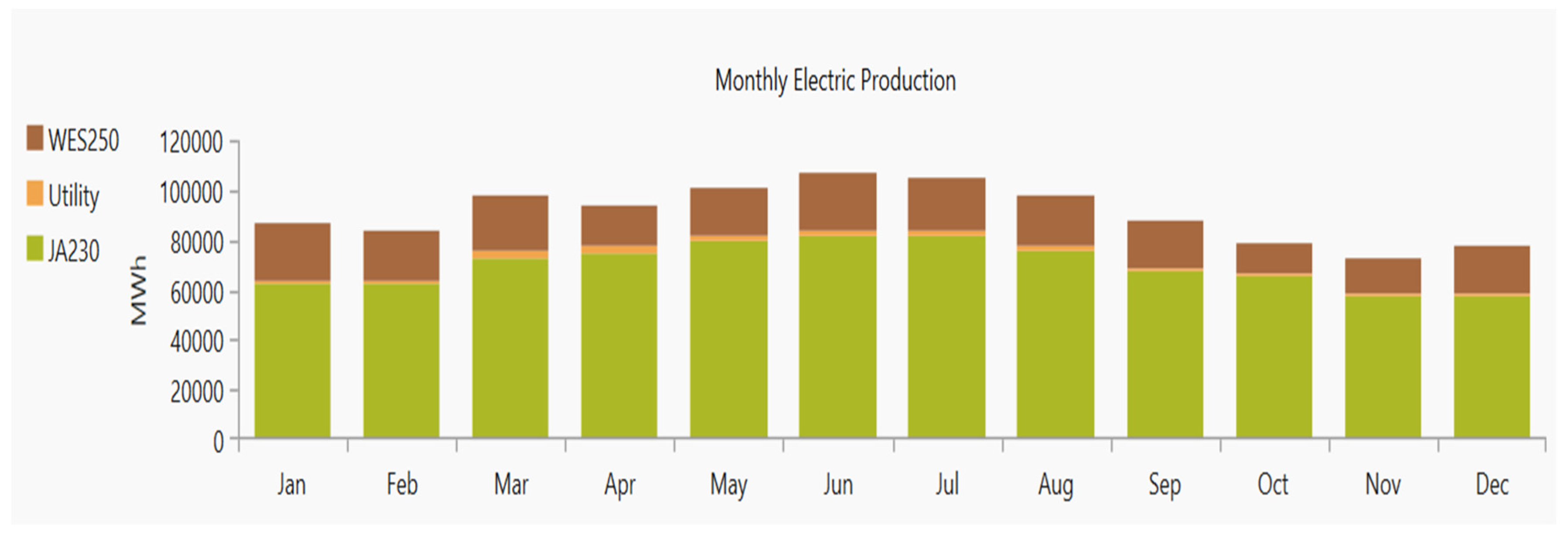
| Criteria | Weight | Sub-Criteria | Weight | Normalized Weight | Order | CR |
|---|---|---|---|---|---|---|
| Climatic | 0.533 | PVOUT | 0.457 | 0.244 | 1 | 0.769 |
| Average temperature | 0.393 | 0.209 | 2 | |||
| Precipitation | 0.150 | 0.080 | 7 | |||
| Topographic | 0.161 | Aspect | 0.114 | 0.018 | 9 | |
| Elevation | 0.511 | 0.082 | 5 | |||
| Slope | 0.375 | 0.060 | 8 | |||
| Economic | 0.204 | Distance to transmission lines | 0.600 | 0.122 | 3 | |
| Distance to main roads | 0.400 | 0.082 | 5 | |||
| Environmental | 0.102 | Land use/cover | 1.000 | 0.102 | 4 | |
| Total | 1.000 | |||||
| Criteria | Weight | Sub-Criteria | Weight | Normalized Weight | Order | CR |
|---|---|---|---|---|---|---|
| Climatic | 0.522 | Wind power density | 0.856 | 0.447 | 1 | 0.911 |
| Average temperature | 0.144 | 0.075 | 5 | |||
| Topographic | 0.197 | Elevation | 0.811 | 0.160 | 2 | |
| Slope | 0.189 | 0.037 | 6 | |||
| Economic | 0.141 | Distance to transmission lines | 0.871 | 0.123 | 4 | |
| Distance to main roads | 0.129 | 0.018 | 7 | |||
| Environmental | 0.140 | Land use/cover | 1.000 | 0.140 | 3 | |
| Total | 1.000 | |||||
| Component | Parameter | Value (Unit) |
|---|---|---|
| Wind turbine [3] | Model name | Wind energy solutions |
| Hub height | 48 (m) | |
| Rated capacity | 250 (kW) | |
| Lifetime | 20 (years) | |
| Capital | 750,000 (USD/unit) | |
| Replacement | 625,000 (USD/unit) | |
| O&M | 6250 (USD/unit/year) | |
| Photovoltaic [3] | Model name | JA solar |
| Module type | Flat plate | |
| Tracking system | Horizontal axis, daily adjustment | |
| Rated capacity | 0.23 (kW) | |
| Lifetime | 25 (years) | |
| Derating factor | 88 (%) | |
| Capital | 290 (USD/kW) | |
| Replacement | 290 (USD/kW) | |
| O&M | 7 (USD/kW/year) | |
| Grid [26] | Grid power price | 0.0853 (USD/kWh) |
| Grid sell-back price | 0.04265 (USD/kWh) | |
| Battery [3] | Model name | Generic 100 kWh Li-Ion |
| Type | Li-Ion | |
| Nominal capacity | 100 (kWh) | |
| Initial state of charge | 100 (%) | |
| Minimum state of charge | 20 (%) | |
| Lifetime | 15 (years) | |
| Capital | 70,000 (USD/unit) | |
| Replacement | 70,000 (USD/unit) | |
| O&M | 1000 (USD/unit/year) | |
| Converter [3] | Model name | System converter |
| Inverter input efficiency | 95 (%) | |
| Relative capacity | 100 (%) | |
| Rectifier input efficiency | 95 (%) | |
| Lifetime | 15 (years) | |
| Capital | 300 (USD/kW) | |
| Replacement | 300 (USD/kW) | |
| O&M | 0 (USD/kW/year) |
| Parameters | Values |
|---|---|
| NPC | USD 201 million |
| LCOE | 0.0344 USD/kWh |
| Operation cost | −6.85 million USD/year |
| Installation cost | USD 282 million |
| Renewable fraction | 91.7% |
| Energy purchased from grid | 41 GWh |
| Energy sold back to grid | 403.4 GWh |
| CO2 emissions | 25,896,121 kg/year |
| Total jobs created | 1152 jobs |
| Parameters | Values |
|---|---|
| NPC | 839 million USD |
| LCOE | 0.129 USD/kWh |
| Operation cost | −1.62 million USD/year |
| Installation cost | 858 million USD |
| Renewable fraction | 96.1% |
| Energy purchased from grid | 21.6 GWh |
| Energy sold back to grid | 461.3 GWh |
| CO2 Emissions | 13,639,598 kg/year |
| Total jobs created | 1201 jobs |
Disclaimer/Publisher’s Note: The statements, opinions and data contained in all publications are solely those of the individual author(s) and contributor(s) and not of MDPI and/or the editor(s). MDPI and/or the editor(s) disclaim responsibility for any injury to people or property resulting from any ideas, methods, instructions or products referred to in the content. |
© 2024 by the authors. Licensee MDPI, Basel, Switzerland. This article is an open access article distributed under the terms and conditions of the Creative Commons Attribution (CC BY) license (https://creativecommons.org/licenses/by/4.0/).
Share and Cite
Yanbuawi, S.M.; Imam, A.A.; Alhussainy, A.A.; Alghamdi, S.; Hariri, F.; Rawa, M. Optimization and Sensitivity Analysis of Using Renewable Energy Resources for Yanbu City. Sustainability 2024, 16, 10487. https://doi.org/10.3390/su162310487
Yanbuawi SM, Imam AA, Alhussainy AA, Alghamdi S, Hariri F, Rawa M. Optimization and Sensitivity Analysis of Using Renewable Energy Resources for Yanbu City. Sustainability. 2024; 16(23):10487. https://doi.org/10.3390/su162310487
Chicago/Turabian StyleYanbuawi, Salman M., Amir A. Imam, Abdullah Ali Alhussainy, Sultan Alghamdi, Fahd Hariri, and Muhyaddin Rawa. 2024. "Optimization and Sensitivity Analysis of Using Renewable Energy Resources for Yanbu City" Sustainability 16, no. 23: 10487. https://doi.org/10.3390/su162310487
APA StyleYanbuawi, S. M., Imam, A. A., Alhussainy, A. A., Alghamdi, S., Hariri, F., & Rawa, M. (2024). Optimization and Sensitivity Analysis of Using Renewable Energy Resources for Yanbu City. Sustainability, 16(23), 10487. https://doi.org/10.3390/su162310487






